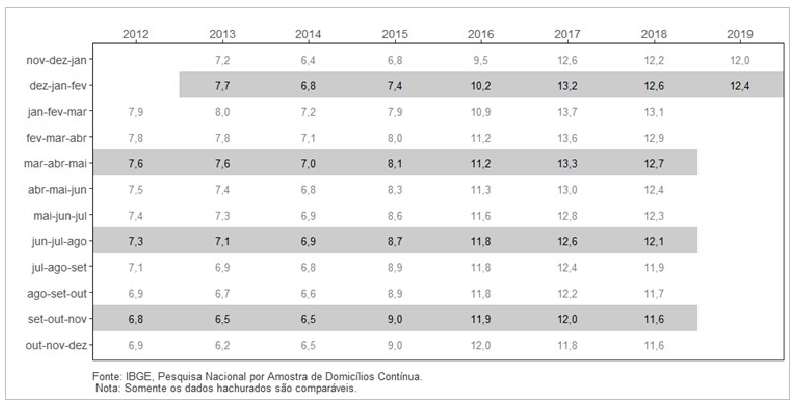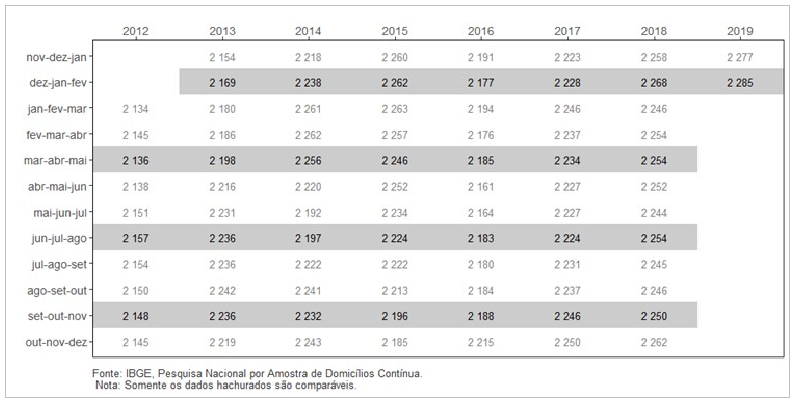Continuous PNAD: unemployment rate is 12.4%, underutilization rate is 24.6% in quarter ending in February 2019
March 29, 2019 09h00 AM | Last Updated: April 01, 2019 04h06 PM
The unemployment rate (12.4%) rose 0.9 percentage points (p.p.) in the moving quarter ended in February 2019 in relation to the quarter from September to November 2018 (11.6%). The rate was stable in relation to the moving quarter between December 2017 and February 2018 (12.6%).
| Indicator/Period | Dec-Jan-Feb 2019 | Sep-Oct-Nov 2018 | Dec-Jan-Feb 2018 |
|---|---|---|---|
| Unemployment rate | 12.4% | 11.6% | 12.6% |
| Underutilization rate | 24.6% | 23.9% | 24.2% |
| Usual real earnings | R$2,285 | R$2,250 | R$2,268 |
| Change of usual real earnings in relation to: | 1.6% | 0.7% (stable) | |
The unemployed population (13.1 million) increased 7.3% (more 892 thousand persons) against the quarter between September and November 2018 (12.2 million). It remained stable compared with the same quarter in 2018.
The employed population (92.1 million) dropped -1.1% (less 1,062 million persons) in relation to the quarter from September to November 2018 and rose 1.1% (more 1,036 million persons) in relation to the quarter between December 2017 and February 2018.
The population out of the workforce (65.7 million) was a record in the time series, having risen 0.9% (more 595 thousand persons) against the quarter from September to November 2018 and 1.2% (more 754 thousand persons) against the same quarter in 2018.
The underutilization rate of the workforce (24.6%) in the quarter ended in February 2019 increased 0.8 p.p. in relation to the previous quarter (23.9%). It rose 0.4 p.p. compared with the same moving quarter a year ago (24.2%).
The underutilized population (27.9 million) was a record in the time series, having risen 3.3% (more 901 thousand persons) in relation to the quarter from September to November 2018 (27.0 million) and 2.9% (more 795 thousand persons) in relation to the same quarter in 2018.
The number of discouraged persons (4.9 million) was a record in the time series, having remained stable in relation to the quarter between September and November 2018 and having risen 6.0% (more 275 thousand persons) in relation to the same moving quarter last year.
The percentage of discouraged persons (4.4%) maintained the record in the time series, having remained stable in relation to the previous quarter and having increased 0.2 p.p. against the same moving quarter in 2018 (4.2%).
The number of persons employed in the private sector with a formal contract (excluding domestic workers) was 33.0 million persons, remaining stable in both comparisons. Conversely, the number of persons employed without a formal contract (11.1 million) fell (-4.8%) compared with the previous quarter (less 561 thousand persons) and rose 3.4% (more 367 thousand persons) compared with the same quarter in 2018.
The category of those self-employed workers (23.8 million) remained stable in the comparison with the previous quarter and increased 2.8% in relation to the same quarter last year (more 644 thousand persons).
The average usual real earnings (R$2,285) rose 1.6% against the previous quarter and remained stable in relation to the same quarter a year ago. The usual real wage bill(R$205.4 billion) remained stable in both comparisons.
Chart 1 - Unemployment Rate - Brazil - 2012/2019
The unemployment rate (12.4%) rose 0.9 percentage points in the moving quarter ended in February 2019 in relation to the quarter from September to November 2018 (11.6%). The picture was stable in relation to the moving quarter from December 2017 to February 2018, when the rate was estimated at 12.6%.
13.1 million persons were unemployed in Brazil in the quarter between December 2018 and February 2019. This contingent increased 7.3% (more 892 thousand persons) against the quarter from September to November 2018 (12.2 million). It remained stable compared with the same quarter in 2018.
The compound underutilization rate of the workforce – percentage of unemployed persons, time-related underemployed persons and the potential workforce – was 24.6% in the quarter between December 2018 and February 2019, a rise of 0.8 p.p. in relation to quarter from September to November 2018 (23.9%) and of 0.4 p.p. in the comparison with the moving quarter from December 2017 and February 2018 (23.2%).
Compound underutilization rate of the workforce
quarters from December to February - 2012/2019 Brazil (%)
About 27.9 million persons were underutilized in Brazil in the quarter from December 2018 to February 2019, the biggest contingent in the time series. It rose 3.3% (more 901 thousand persons) against the quarter between September and November 2018 and 2.9% (more 795 thousand underutilized persons) in the comparison with the quarter from December 2017 to February 2018.
The contingent of underemployed persons in terms of number of hours worked (6.7 million) reduced -4.8% in relation to the previous quarter (-341 thousand persons) and increased 7.9% (more 491 thousand persons) in relation to the quarter between December 2017 and February 2018.
The contingent out of the workforce (65.7 million) rose by 595 thousand persons (0.9%) compared with the quarter from September to November 2018 and it was the biggest in the time series. The indicator increased 1.2% (more 754 thousand persons) against the quarter between December 2017 and February 2018.
The discouraged population (4.9 million) remained stable in relation to the quarter between September and November 2018 and rose 6.0% in relation to the quarter from December 2017 to February 2018 (4.6 million). This contingent hit its highest level in the time series.
The percentage of discouraged persons in relation to the workforce or discouraged population (4.4%) maintained a record in the time series, having remained stable in relation to the previous quarter and having increased 0.2 percentage points against the quarter from December 2017 to February 2018 (4.2%).
The workforce – employed and unemployed persons – was of 105.2 million persons and remained stable in relation to the previous quarter. It rose 1.0% (more 1.0 million persons) against the quarter between December 2017 and February 2018.
The number of employed persons (92.1 million) dropped (-1.1%) over the previous quarter (less 1.062 million persons). It rose 1.1% (more 1.036 million persons) against the quarter between December 2017 and February 2018.
The employment-population ratio – percentage of employed persons in the population at working age – was 53.9% in the quarter ended in February and dropped -0.8 p.p. against the previous quarter (54.7%). It remained stable in relation to the quarter between December 2017 and February 2018.
The number of persons employed in the private sector with a formal contract (excluding domestic workers) was 33.0 million persons, staying stable in both comparisons.
The number of persons employed in the private sector without a formal contract (11.1 million) fell (-4.8%) in the comparison with the previous quarter (less 561 thousand persons). It rose 3.4% in relation to the quarter from December 2017 to February 2018 (more 367 thousand persons).
The number of self-employed workers (23.8 million) remained stable in relation to the previous quarter and increased 2.8% over the quarter between December 2017 and February 2018 (more 644 thousand persons).
The group of employers (4.5 million persons) remained stable in relation to the previous quarter and rose 4.2% (more 183 thousand persons) in relation to the quarter from December 2017 to February 2018.
The group of domestic workers (6.2 million) remained stable in both comparisons.
Estimated at 11.3 million persons the group of those employed in the public sector (including statutory servants and military) fell (-3.8%) against the previous quarter and remained stable against the quarter between December 2017 and February 2018.
The average usual real earnings (R$2,285) increased 1.6% over the previous quarter and remained stable in relation to the quarter from December 2017 to February 2018.
The usual real wage bill (R$205.4 billion) remained stable in both comparisons.
Average monthly usual real earnings from all jobs
Brazil - 2012/2019 - (R$)




